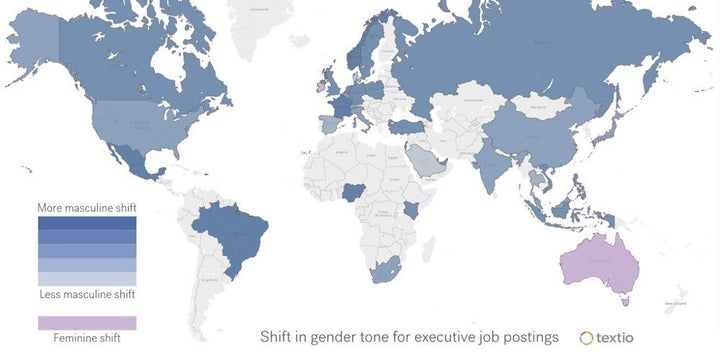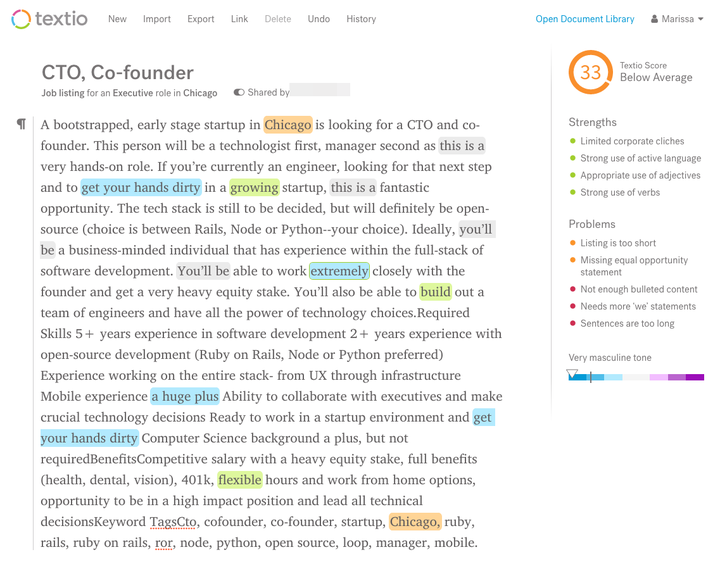
Would you consider yourself a driven, experienced leader eager to get your hands dirty?
Then you’re likely a man.
Job listings that include words and phrases like “get your hands dirty” and “driven” are more likely to attract male applicants, according to data analysis done by a machine-learning startup called Textio.
And these characteristically masculine terms are used even more frequently in postings for higher-paying positions, according to new data from the company, which studies millions of real job listings and related information to find patterns and trends that help companies hire more efficiently ― and without bias.
The findings add another layer of explanation for the lack of women at the top in the business world.
“It is not super surprising that the listings skew more male, when you look at composition of executive teams,” Kieran Snyder, Textio’s CEO and cofounder told The Huffington Post. Majority-male executives are probably driving the job requirements for these roles and using characteristic language.
Textio keeps a database of nearly 100 million real-world job listings, updated constantly. The two-and-a-half-year-old startup also gets information from clients (including CVS, Johnson & Johnson and Cisco) on how long it takes to fill a job, as well as who was hired ― their age, gender, ethnicity, etc. Data is in the aggregate so no personally identifiable information is shared.
You’d think that some jobs just naturally attract more women than men ― for example, guys are just are more interested in leadership roles ― but Textio has found that the language in the job post itself is also important.
And they’ve tested this theory at a few big companies. Travel company Expedia, for example, rejiggered a job posting for an engineering role to include more feminine toned language and they hired more women, Snyder said. The original job post had skewed male. The company saw similar results with jobs posted by Johnson & Johnson.
Other social science research has turned up words and phrases more likely to appeal to women than men. And another startup called Unitive is also a software program that helps analyze job listings for bias.
Textio claims to take the research further. By looking at real data, the company was able to turn up some language that isn’t on anyone’s list of gendered words. These include exhaustive, enforcement and fearless (masculine) and transparent, catalyst, and in touch with (feminine). The company has venture backing from a few well-known Silicon Valley investors.
For this recent report, the company looked at global job data, comparing listings for lower-level roles with those for executive roles ― including titles with “chief” in them like CEO, COO, CTO, CFO, those with “president,” like vice president and senior vice president, as well as director-level jobs.
In only two countries were executive job listings written with a more feminine slant: Australia and Ireland.

The company provided examples of male-biased and female-biased executive jobs.
Here’s a real female-slanted posting for a chief technology officer at a company, with its name changed to Acme.

And here’s a CTO job-listing that skews male:

Despite the fact that women now make up nearly half of the labor market, and have for a while, they’re still conspicuously absent from the top of the org chart. Only 5 percent of Fortune 500 CEOs are women. And around the world, women hold only 24 percent of senior roles, according to a 2016 study.
In one sense, the reason for the imbalance is simple and boils down to sexism. Women were long dismissed as serious workers or leaders and explicitly not welcome at the top of the corporate ladder.
Yet, in 2017, overt prejudice is less likely the driving factor for gender imbalances. Instead, there are more practical obstacles, like a lack of paid leave or the pressure on women to take on the primary responsibility for care taking at home and put their careers on ice. And a variety of implicit biases that play out at work that are harder to see and fight.
As this data show: Some of that implicit bias starts before you even land the job.
